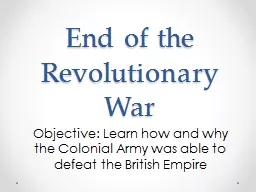

Objective Learn how and why the Colonial Army was able to defeat the British Empire British Officials Flee After the Declaration of Independence colonies began to build up armies and create their own governments ID: 496543
Download Presentation The PPT/PDF document "End of the Revolutionary War" is the property of its rightful owner. Permission is granted to download and print the materials on this web site for personal, non-commercial use only, and to display it on your personal computer provided you do not modify the materials and that you retain all copyright notices contained in the materials. By downloading content from our website, you accept the terms of this agreement.
Slide1
End of the Revolutionary War
Objective: Learn how and why the Colonial Army was able to defeat the British EmpireSlide2
British Officials Flee
After the Declaration of Independence colonies began to build up armies and create their own governments
British officials had no power to stop this from happening and feared for their safety
Many began fleeing back to England, which left the British with even less control over the ColoniesSlide3
The tide begins to turn
Although the British Army was winning almost every battle early in the war, things were starting to change
Generals like George Washington stopped engaging the British directly, instead using guerilla tactics
France and Spain continued to support the Colonial ArmySlide4
Guerilla Warfare
Guerilla warfare involves “hit and run” tactics
Guerilla warfare will often avoid direct engagements, making it difficult for the attacking army to make any progress
Fighters in a guerilla army will usually have a strong understanding of their land
Guerilla fighters will often live amongst the publicSlide5
Stop and Think
Does Guerilla Warfare still happen today?Slide6
French and Spanish Aid
France and Spain were both enemies of England, and wanted to help the Colonies win the war
France supplied weapons, supplies, and ships
Thomas Jefferson was a key negotiator for support
As the war went on the French became more and more involvedSlide7
Privateers
Since the Colonial Army did not have a strong Navy, they relied on Privateers
Privateers were given a license from the government that encouraged them to attack enemy ships
They in turn benefitted by keeping a share of the plunder
This was also embarrassing for the British Navy, causing division within their commandSlide8
Stop and Think
How are Privateers different from Pirates?Slide9
Battle of Yorktown
During September and October of 1781 George Washington and the French forces had cornered the British Army at Yorktown
Lord Cornwallis was the British commanding officer
British forces surrendered on 10/17/1781
Yorktown was the last major battle of the Revolutionary WarSlide10
Treaty of Paris
Signed 9/3/1783
United States became it’s own independent country, free from British rule
Established a boundary between the United States and British holdings in North America
Both England and the US were interested in maintaining tradeSlide11
Consequences of the War
25,000 American casualties, 24,000 British casualties
Both the United States and Britain suffered financially after the war
The war had forced the United States to create an Army, Navy, banking systems, and early forms of government
Articles of Confederation were introduced